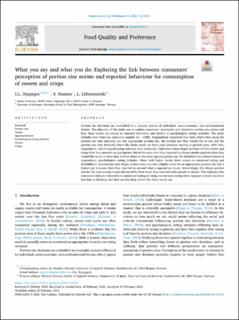| dc.contributor.author | Djupegot, Ingrid Laukeland | |
| dc.contributor.author | Hansen, Susanne | |
| dc.contributor.author | Lähteenmäki, Liisa | |
| dc.date.accessioned | 2021-04-12T09:28:33Z | |
| dc.date.available | 2021-04-12T09:28:33Z | |
| dc.date.created | 2021-03-19T13:05:29Z | |
| dc.date.issued | 2021 | |
| dc.identifier.citation | Djupegot, I. L., Hansen, S., & Lähteenmäki, L. (2021). What you say and what you do: Exploring the link between consumers’ perception of portion size norms and reported behaviour for consumption of sweets and crisps. Food Quality and Preference, 92, 104216. | en_US |
| dc.identifier.issn | 0950-3293 | |
| dc.identifier.uri | https://hdl.handle.net/11250/2737257 | |
| dc.description.abstract | Portion size decisions are embedded in a complex system of individual, socio-economic, and environmental factors. The objective of this study was to explore consumers’ descriptive and injunctive portion size norms and how these norms are related to reported behaviour and further to psychological eating attitudes. The study includes data from two consumer samples (n = 1020). Respondents completed four tasks where they chose the portion size they normally eat, the appropriate portion size, the portion size they would like to eat, and the portion size they believed others like them would eat from eight pictures varying in portion sizes. After this, respondents’ psychological eating attitudes were measured. Consumers chose larger portions of both sweets and crisps than they perceive as appropriate, but at the same time they reported to choose smaller portions than they would like to eat or what they believe others at the same age and gender eat. We identified two clusters based on respondents’ psychological eating attitudes. Those with higher versus lower scores on emotional eating and disinhibition reported not only larger portion sizes, but also a higher norm for an appropriate portion size and a higher gap between what they reported to eat and what is appropriate to eat. Interestingly, the chosen portion size for the high scoring cluster did not differ from those they reported other people to choose. This indicates that consumers that are vulnerable to emotional eating or losing control over eating when exposed to food cues have less bias in thinking that they eat less than others like them would eat. | en_US |
| dc.language.iso | eng | en_US |
| dc.publisher | Elsevier | en_US |
| dc.rights | Navngivelse 4.0 Internasjonal | * |
| dc.rights.uri | http://creativecommons.org/licenses/by/4.0/deed.no | * |
| dc.title | What you say and what you do: Exploring the link between consumers’ perception of portion size norms and reported behaviour for consumption of sweets and crisps | en_US |
| dc.type | Journal article | en_US |
| dc.type | Peer reviewed | en_US |
| dc.description.version | publishedVersion | en_US |
| dc.rights.holder | © 2021 The Authors. | en_US |
| dc.source.volume | 92 | en_US |
| dc.source.journal | Food Quality and Preference | en_US |
| dc.identifier.doi | 10.1016/j.foodqual.2021.104216 | |
| dc.identifier.cristin | 1899308 | |
| dc.source.articlenumber | 104216 | en_US |
| cristin.ispublished | true | |
| cristin.fulltext | original | |
| cristin.qualitycode | 1 | |

